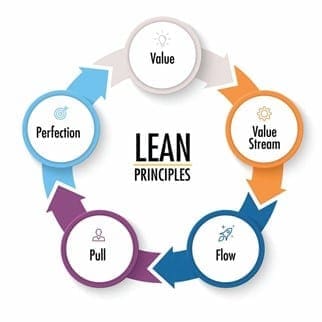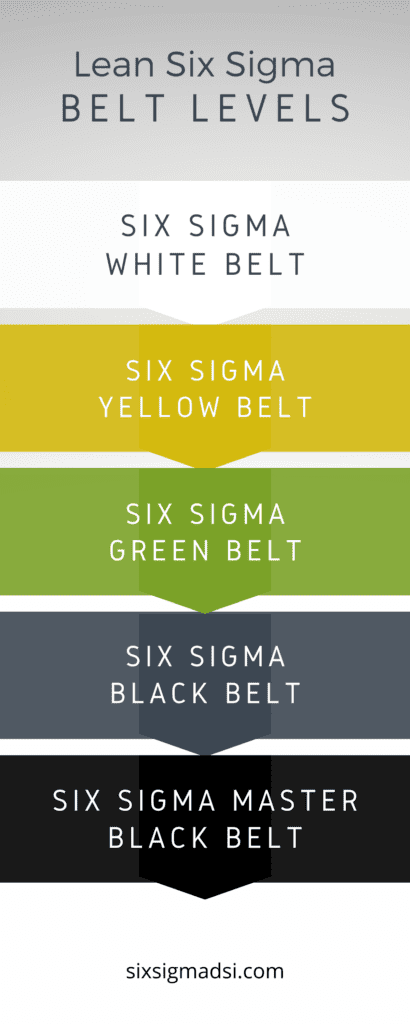- What is Six Sigma?
- What is Lean Six Sigma?
- Six Sigma Principles
- The Six Sigma Methodology
- The Six Sigma Belt Levels
- The Benefits of Lean Six Sigma for Organizations
- The Benefits of Lean Six Sigma for Your Career
- What are the Six Sigma Career Options & Average Salary?
- Why Should You Certify?
- Related Articles:
What is Six Sigma?
Six Sigma is an approach and set of tools that are used to improve the efficiency and quality of business processes. It reduces errors and defects, minimizes variation, and increases quality. Lean Six Sigma aims to achieve near-perfect quality with only 3.4 errors per million opportunities. DMAIC is a structured method that identifies and eliminates causes of variation and improves processes.
The Greek letter “sigma” is the basis of the etymology. This statistical term measures deviations from a process’ mean or target. Six Sigma is derived from the bell curve in statistics. One Sigma represents a standard deviation. The defect rate will be classified as “extremely small” if the process has six Sigmas. This means that there are three Sigmas above the mean and three Sigmas below it.
What is Lean?
LEAN leverages the understanding of what steps in the process add value to the customer and maximizing that value by reducing the steps that do not add value (otherwise known as “waste’).
The goal of LEAN is to reduce waste in the process. By reducing waste in the process, you will reduce the number of tasks occurring in the process. This reduction of wasteful steps will gain the organization:

What is Lean Six Sigma?
Lean Six Sigma is an approach that combines Lean with Six Sigma, two powerful techniques for process improvement.
Lean is a philosophy that aims to maximize efficiency and minimize waste by eliminating activities that do not add value. This includes streamlining processes, reducing defects, improving quality, as well as optimizing resources in order to deliver more with less effort.
Six Sigma, on the other hand, is a statistical method of process improvement that aims to reduce variations and defects through data-driven decisions. It involves defining processes, measuring them, analyzing them, and improving and controlling them to get consistent and predictable outcomes.
Lean Six Sigma combines the strengths of both methodologies to provide a comprehensive approach to process improvement. It can be used in any industry or sector. It is widely applied in the manufacturing, healthcare, and finance industries, as well as service industries, to improve efficiency and reduce costs.
Six Sigma Principles
The goal of Six Sigma is to deliver near-perfect products and services in order to transform businesses for maximum customer satisfaction.
Six key principles are the foundation of Six Sigma:
- Focus on the customer: The widespread belief is that “the customer is king.” It is the primary objective to maximize benefits for customers. To achieve this, businesses must understand their customers, what motivates them, and the needs they have. To do this, a business must establish a standard of quality based on what customers or the market demand.
- You can find your problem by measuring the value stream: To determine waste areas, map the steps of a process. Data is needed to identify the problem areas that need to be transformed or addressed. Set clear goals: Included in this are the definition of the data to collect, the purpose for data collection, the insights expected, assuring the accuracy and precision of measurements, as well establishing a standard data collection system. Determine if the collected data helps to achieve goals. If so, refine the data or collect additional information. Identify the issue. Ask questions to find out the cause.
- Remove the waste: After identifying the problem, modify the process in order to eliminate variations and remove defects. The process should be streamlined to remove activities that don’t add value for the customer. Tools are used if the value stream does not reveal the root cause of the problem. To achieve efficiency and quality control, streamline functions. By removing the junk mentioned above, you can remove bottlenecks from the process.
- “Keep the ball rolling”: All stakeholders should be involved. Adopt a structured approach whereby your team collaborates to solve problems using their diverse expertise.
- Six Sigma processes: The team must be familiar with the principles and methods used. To reduce the risks of project failure or re-design, and to ensure the process is performing optimally, it’s important that the team has specialized knowledge and training.
- A flexible and responsive ecosystem is essential: Six Sigma is about business transformation and change. If a flawed or inefficient procedure is eliminated, this calls for a shift in employee behavior and work practices. A culture that is flexible and open to change can help ensure smooth project implementation. To facilitate this, the processes should be designed to be easy to adopt. A company with an eye on the data, who examines the bottom line periodically and adjusts where necessary can gain a competitive advantage.

The Six Sigma Methodology
DMAIC and DMADV are the two most important Six Sigma methods. Each of these methodologies has its own set of recommended procedures for business transformation.
DMAIC uses data to improve products and services. The acronym DMAIC stands for five phases. D – Define, Measure, Analyse, and Improve. DMAIC can be used in the production of a product, or to deliver a service.
DMADV is a component of the Design for Six Sigma process (DFSS), which is used to redesign or re-design processes in product manufacturing and service delivery. DMADV is divided into five phases: D – Define, M – Measure, A – Analyse, and D – Design. DMADV can be used when the existing process does not meet the customer’s needs, even after optimizing it, or when new methods are required. Six Sigma Green Belts, Six Sigma Black Belts, and Six Sigma Master Black Belts supervise the execution of this process. Later, we’ll talk about the belts.
Professionals who want to learn these two methods in a variety of business settings would be well advised to enroll in an online certificate course taught by experts.
The Six Sigma Belt Levels
The Six Sigma Certified Training levels are designed to meet specific training requirements and criteria.
White Belt
This is the easiest stage where:
- Anyone can join.
- Problem-solving teams are formed to solve problems.
- Participants must understand Six Sigma fundamental concepts.
Yellow Belt
The participant is:
- Participates as a member of a project team.
- Reviewing process improvements
- Learn about DMAIC and the different methodologies.
Green Belt
The following criteria are required to reach this level of expertise:
- Three years minimum of full-time work experience.
- Understanding the tools and methods used to solve problems.
- Experience in a project involving business transformation.
- Guideline for Black Belt Projects in Data Collection and Analysis.
- Lead Green Belt teams or projects.
Black Belt
This level includes:
- Three years minimum full-time employment
- Work experience in core knowledge areas
- Proof of completing at least two Six Sigma projects
- Demonstration expertise in applying multivariate metrics across diverse business change settings
- Leading diverse teams to solve problems.
- Project teams can be trained and coached by a professional.
Master Black Belt
To achieve this level, candidates must:
- Black Belt Certification
- Minimum of five years of full-time work experience or proof of completion of at least 10 Six Sigma projects
- Green Belts, and Black Belts, and I have coached and taught them.
- Develop key metrics, strategies, and tactics.
- Worked as a Six Sigma Technologist for an organization and as a business transformation advisor.

The Benefits of Lean Six Sigma for Organizations
Being Certified in Lean Six Sigma provides numerous benefits for organizations. It not only saves money but also changes the attitude of employees and the functionality of the organization. Through the implementation of Lean Six Sigma, organizations can expect the following beneficial outcomes:
- Increase in Profit: As a result of eliminating waste and improving the quality of production, Lean Six Sigma reduces costs for organizations and increases profitability. General Electric experienced profit-cost savings exceeding $2 billion.
- Standardized and Simplified Processes: With the help of value stream mapping, Lean Six Sigma eliminates waste in processes and unnecessary steps to streamline production. The processes are simplified so that they are easier to follow and less likely to lead to error. The simplified processes will also reduce time, leading to a decrease in overhead costs.
- Decrease in errors: With the simplification in processes steps and a detailed investigation into the main causes of error and waste in the organization, Lean Six Sigma drastically reduces errors such as defects and miscalculations
- Employee Performance/Development: Lean Six Sigma stresses the importance of the ideas and observances of individual employees to the overall success of an organization. With Lean Six Sigma, the feeling of self-importance and significance increases among employees and leads to an increase in motivation and better job performance.
- Value to Customer: Lean Six Sigma allows companies to improve their processes and the quality of their products. In turn, they can produce more products at a cheaper price with less error. Customer satisfaction will increase, which will then lead to an increase in customer loyalty.
The Benefits of Lean Six Sigma for Your Career
Certified Lean Six Sigma practitioners are in high demand in all industries across the globe. The Lean Six Sigma methodology is applicable in manufacturing, finance, government, healthcare, retail, insurance, IT, and more. Some of the benefits a Lean Six Signa practitioner brings to the organization are:
- An ability to drive process thinking to identify and fix opportunities
- The capability to define critical performance measures and improve overall performance
- Learn how to measure and improve core business KPIs
- Develop your project management skills to drive high-performing teams
- Develop your ability to manage and engage senior Stakeholders
- Learn and become familiar with core change management skills
- Deepen your business understanding and insights
- Improve your career transition and gain an edge over other candidates
- Making data-driven decisions in your everyday activities
- It will change the way you work forever
These skills are highly sought after in leadership positions. Being certified in Lean Six Sigma will give you an advantage over the competition. It is a powerful credential to add to your resume.
What are the Six Sigma Career Options & Average Salary?
Six Sigma is used in many industries, including manufacturing, healthcare, and finance. Being Six Sigma certified offers a variety of career options and attractive salary prospects.
- Six Sigma Consultant: Six Sigma consultants advise organizations on improving processes, identify areas of cost savings and develop strategies for implementation. Six Sigma consultants earn an average of $96,000 per year.
- Six Sigma Project Manager – A Six Sigma project manager oversees Six Sigma initiatives, manages the project teams, and ensures that process improvements are implemented successfully. Six Sigma project managers earn an average of around $107,000 a year.
- Six Sigma Black Belt – A Six Sigma Black Belt leads Six Sigma projects and trains, team members. They also ensure that process improvements are sustained. The average salary per year is approximately $110,000.
- Six Sigma Master Black Belt is the highest certification in Six Sigma. Its responsibilities include leading Six Sigma initiatives within an organization, coaching and mentoring Six Sigma Black Belts or Green Belts as well as driving business transformation. Six Sigma Master Black Belts earn an average of $140,000 per year.
- Quality Manager: The Quality Manager is responsible for ensuring that the products and services of an organization meet regulatory requirements, customer expectations, and industry standards. Six Sigma certification is useful for this role. The average salary of a Quality Manager in the United States is $91,000.
Six Sigma is a career that offers many opportunities and competitive salaries. Six Sigma-certified individuals can expect better salaries and job prospects.
Why Should You Certify?
The Lean Six Sigma Training validates professionals that are capable of identifying risks, mistakes, or defects within a business and eliminating them.
Six Sigma certification and courses require individuals to demonstrate their expertise. The certification will help you to become an expert in process improvement, and it will increase your credibility.
How to Get Started?
First, you should choose which belt level suits you. You can start with either the yellow belt or the white belt. You can also ask us for expert advice on how to achieve six sigma certifications in your career.
After, you should enroll in the best Lean Six Sigma training course. At SSDSI, we offer onsite, public and virtual training. We are certified as an Accredited Training Organization with the International Association of Six Sigma Certification (IASSC).













I have some of the Six Sigma tools on my job
I LOVED THIS COURSE SO MUCH. BOOSETED MY MONIES BY $1000k